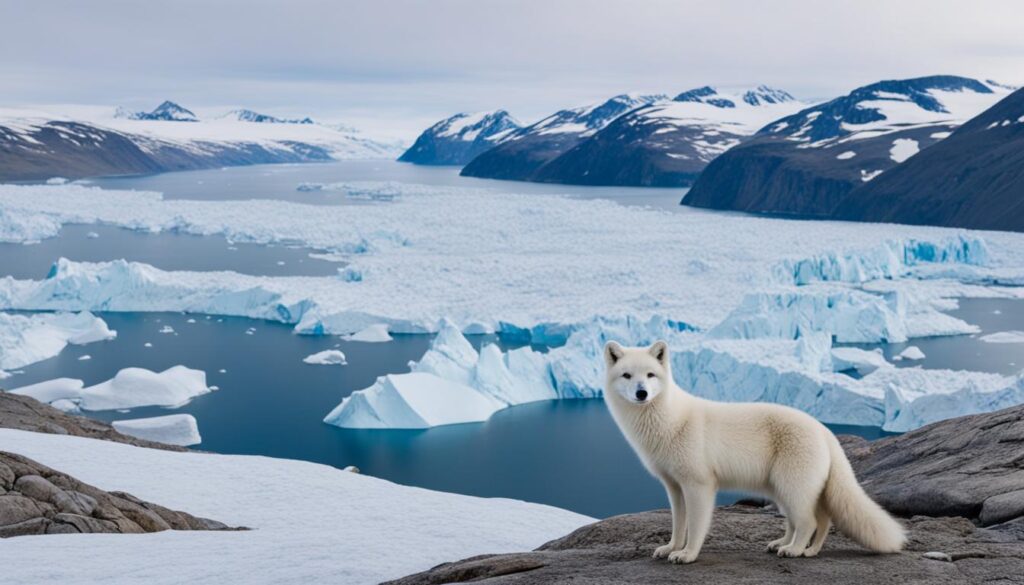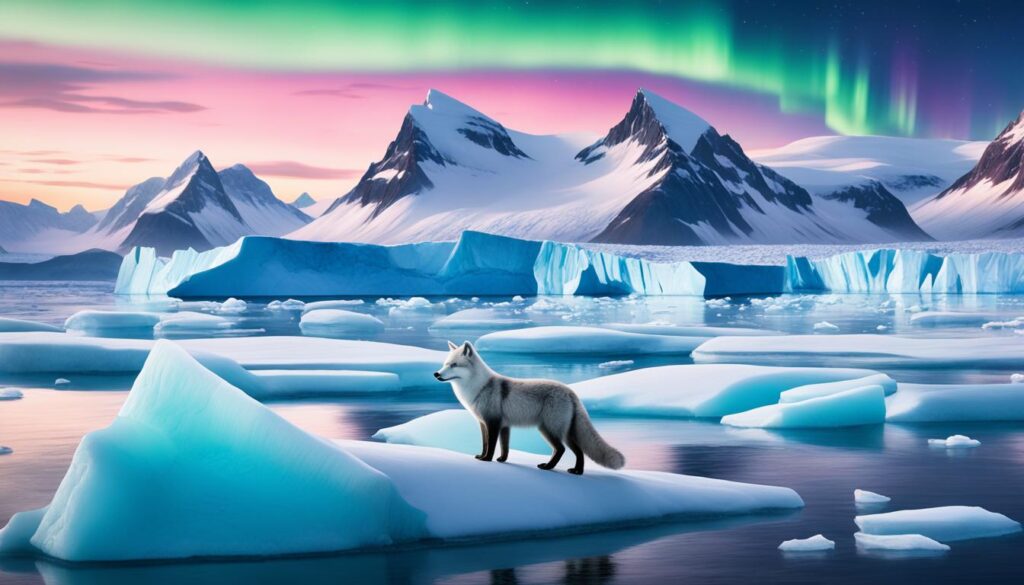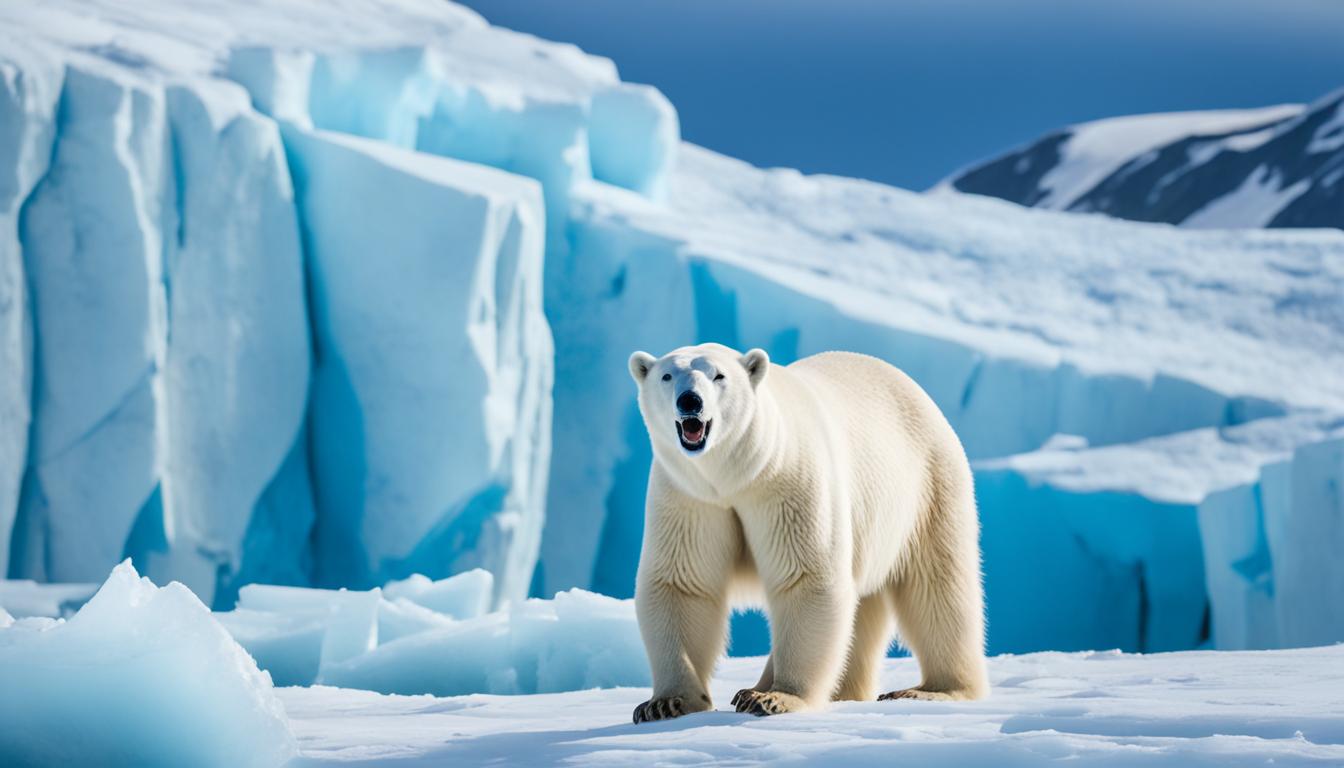Explore Greenland National Parks | Spectacular Beauty
Imagine a land where the arctic circle embraces breathtaking landscapes, where glacial wonders and diverse wildlife exist in harmony, and where outdoor adventure meets wildlife conservation. Welcome to Greenland National Parks, an ecotourism destination like no other. But have you ever wondered what makes these parks so special?
In this article, we will delve into the wonders of Greenland National Parks, including the Northeast Greenland National Park, the largest national park in the world. We will uncover the spellbinding beauty of its glacial landscapes, the thriving wildlife that calls these parks home, and the conservation efforts in place to preserve this pristine environment. So get ready to embark on a journey of discovery as we unveil the secrets of Greenland National Parks and challenge your perception of the Arctic wilderness.
Key Takeaways:
- Greenland National Parks offer untouched natural beauty within the Arctic Circle
- These parks are UNESCO World Heritage Sites, attracting outdoor adventure enthusiasts
- Diverse wildlife can be encountered, including polar bears, walrus, and various bird species
- The Northeast Greenland National Park is the largest national park globally, covering 972,000 square kilometers
- The park’s landscape showcases majestic mountains, fjords, and the massive Greenland Ice Sheet
Wildlife in Greenland National Parks
The national parks in Greenland are home to a diverse range of fascinating wildlife, offering visitors a one-of-a-kind opportunity to experience arctic ecosystems up close. While the animal populations may not rival those of African national parks, the unique species found here make for an awe-inspiring encounter with nature.
The star attraction of these parks is undoubtedly the majestic polar bear. With a significant population within the national parks, spotting these magnificent creatures in their natural habitat is a thrilling experience. Their sheer size and powerful presence leave a lasting impression on visitors.
Another notable inhabitant of Greenland’s national parks is the walrus. These massive marine mammals can be observed basking on ice floes, their impressive tusks and distinctive appearance making them a sight to behold.
The narwhal, often referred to as the “unicorns of the sea,” is another remarkable creature found in these parks. Known for their long spiral tusks, which can grow up to 10 feet in length, narwhals grace the Arctic waters and are a true marvel to witness.
Exploring the Arctic tundra of Greenland’s national parks may also bring you face to face with the elusive Arctic wolf. These beautiful predators, superbly adapted to the harsh environment, roam the vast expanses, blending into the snow-covered terrain.
The muskoxen, with their thick fur and formidable horns, are an iconic species found in these arctic parks. These ancient creatures have managed to survive in the harsh conditions, and glimpsing them in their natural habitat is a unique privilege.
While smaller in size, the lemming plays a crucial role in the terrestrial food chain within these parks. These tiny rodents are an important source of food for various predators, perpetuating the delicate balance of the ecosystem.
Greenland’s national parks also provide a haven for avian species. Throughout the parks, visitors can marvel at the sight of numerous bird species, including ravens, ptarmigans, and gulls, soaring through the Arctic skies and adding their distinct calls to the pristine landscape.
Northeast Greenland National Park – The largest national park in the world

The Northeast Greenland National Park is a breathtaking natural wonder that not only holds the title of being the largest national park in Greenland but also the largest in the entire world. Established in 1974, this vast park covers an immense area of approximately 972,000 square kilometers, making it a truly remarkable protected area.
With its stunning landscapes, diverse ecosystems, and abundant wildlife, the Northeast Greenland National Park attracts visitors from around the globe. Among its many attractions are the magnificent Kaiser Franz Joseph Fjords, renowned for their size and beauty. These fjords offer visitors an unparalleled opportunity to witness awe-inspiring views of towering cliffs, sparkling blue waters, and breathtaking ice formations.
One of the most remarkable features of the Northeast Greenland National Park is the presence of the massive Greenland Ice Sheet. Stretching over 1,700,000 square kilometers, this ice sheet holds 10% of the Earth’s freshwater reserves and is a vital component of our planet’s climate system.
The Greenland Ice Sheet not only shapes the landscape of the national park, but it also plays a crucial role in regulating global sea levels and influencing oceanic currents. It is a sight to behold, with its frozen expanse stretching as far as the eye can see, glistening under the Arctic sun.
Key Facts about the Northeast Greenland National Park
| Established | 1974 |
|---|---|
| Total Area | Approximately 972,000 square kilometers |
| Location | Greenland |
| Size Rank | The largest national park in the world |
| Protected Areas Rank | One of the nine largest protected areas globally |
| Notable Features | Kaiser Franz Joseph Fjords, Greenland Ice Sheet |
Visiting the Northeast Greenland National Park is an extraordinary experience that offers a glimpse into the raw beauty and pristine wilderness of the Arctic. Whether you’re exploring the majestic fjords, marveling at the vastness of the Greenland Ice Sheet, or simply immersing yourself in the tranquility of this untouched landscape, a trip to this remarkable national park is sure to leave you with memories that will last a lifetime.
Location and Landscape of Northeast Greenland National Park

The Northeast Greenland National Park, located in the northeastern region of Greenland, is a vast and breathtaking natural sanctuary. Covering nearly a quarter of the entire island of Greenland, this national park is renowned for its rugged beauty and pristine wilderness. Its geographic location within the Arctic Circle adds to its allure, creating a truly unique and remote destination for nature enthusiasts.
The landscape of the Northeast Greenland National Park is shaped by the imposing presence of the Greenland Ice Sheet. This enormous ice cap, one of the largest in the world, dominates the park’s interior, covering vast areas with its icy expanse. The presence of the Greenland Ice Sheet influences both the climate and the topography of the park, resulting in a diverse and dramatic environment.
“The Northeast Greenland National Park offers a mesmerizing combination of majestic mountains, winding fjords, and tranquil frozen lakes. It is a place of raw beauty and untouched wilderness.”
The park’s mountain ranges rise majestically against the icy backdrop, creating a striking contrast and providing stunning panoramic views. The fjords, carved by ancient glaciers, wind their way through the landscape, offering glimpses of sheer cliffs and serene waterways. Frozen lakes, dotted throughout the park, add to the ethereal beauty of this pristine wilderness. The inhospitable habitats within the Northeast Greenland National Park make it a sanctuary for few species, preserving its untouched nature.
The extreme conditions of the Arctic Circle, with harsh winters and limited resources, make the Northeast Greenland National Park challenging for most forms of life. However, it is precisely this inhospitable environment that has allowed the park to remain an undisturbed habitat for wildlife, free from human interference. Exploring this pristine wilderness provides a unique opportunity to witness nature in its purest form.
Photo: Northeast Greenland National Park
Wildlife Conservation in Northeast Greenland National Park
The Northeast Greenland National Park serves as a sanctuary for various protected species, making it a vital hub for wildlife conservation efforts. Two prominent species that benefit from the park’s protection are muskoxen and polar bears.
The park is renowned for its significant contribution to muskoxen conservation. In fact, it is home to over 40% of the world’s muskoxen population. The abundance of suitable habitats and preservation efforts have helped maintain and enhance their numbers within the park. With their majestic presence and unique adaptations, muskoxen are a true symbol of the Arctic wilderness.
Polar bears, another iconic species, also find refuge in the Northeast Greenland National Park. These magnificent creatures rely on the park’s isolated yet bountiful environment for their survival. Strict regulations have been put in place to protect the polar bears’ habitat and prevent any disturbances that may affect their delicate population. Such measures ensure that future generations can witness the beauty and grandeur of these Arctic icons.
“The Northeast Greenland National Park’s dedication to wildlife conservation is commendable. By safeguarding species like muskoxen and polar bears, the park helps preserve the delicate balance of the ecosystem and contributes to the overall well-being of the Arctic region.” – Wildlife Expert
To maintain the effectiveness of wildlife conservation efforts, the park enforces strict regulations for visitors. These regulations aim to minimize disturbances to the protected species and their habitats. Tourists are required to adhere to these guidelines, such as keeping a safe distance from wildlife and refraining from littering. By respecting these regulations, visitors play a crucial role in preserving the diverse wildlife and the delicate ecosystem of the Northeast Greenland National Park.
| Protected Species | Conservation Importance |
|---|---|
| Muskoxen | Over 40% of the world’s muskoxen population is found in the park. Efforts are made to preserve their habitat and ensure their survival. |
| Polar Bears | The park serves as a refuge for polar bears, with regulations in place to protect their habitat and maintain their population. |
Conclusion
Greenland’s national parks, including the Northeast Greenland National Park, offer a unique and awe-inspiring experience for nature lovers and adventure seekers. These parks are renowned for their stunning glacial landscapes, diverse wildlife, and commitment to wildlife conservation, making them important ecotourism destinations.
A visit to these national parks provides the opportunity to encounter majestic polar bears in their natural habitat, witness the vastness of the Greenland Ice Sheet, and immerse oneself in the untouched beauty of the arctic wilderness. The sheer scale and beauty of these parks are sure to leave a lasting impression on every visitor.
By exploring Greenland’s national parks, visitors can contribute to the preservation of these remarkable ecosystems while enjoying the adventure and serenity they offer. Whether you are a wildlife enthusiast, a nature photographer, or simply seeking a unique travel experience, Greenland’s national parks are a must-visit destination that will captivate your senses and create memories to last a lifetime.







